Questa mattina nel deserto del remoto Sesriem è dedicata alla manutenzione della bici. Non è perché sono così vicino al mio obiettivo adesso, con l'avventura più difficile e le peggiori strade alle spalle, che dovrei rilassarmi e saltarla. Ho ancora 2000 km da percorrere in bici e mi darebbe fastidio rompere qualcosa. Grandi guasti seguono sempre uno schema di manutenzione pigro, quindi approfitto di avere acqua e corrente nel mio lussuoso campeggio per smontare e oliare tutto.
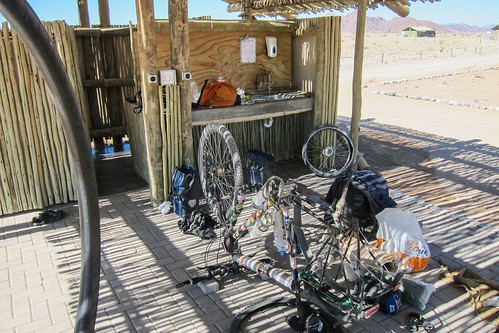
I’m pretty sure I have a slow leak on the rear tube, so patching is on the list too. And I finally give time to my bar-end mirror. I’ve broken it at least five times, and glued it back each time. When on the kick stand, it happens that my bicycle falls down because of the wind or just wrong balance. And if it falls on the side of the bar-end mirror, it just breaks the plastic articulation. It happened for the first time in Gabon.
This time, I won’t use glue but try something more robust: I have a hacksaw blade, so I can shape the plastic bits and screw them back into the handlebar tube. With this, I hope I won’t be mirrorless again.
Sono già le dodici quando vado avanti a pedalare. La città successiva (come in un posto con più di 2 famiglie) è a più di 300 chilometri.
Parto con la mia bici fresca e sulla strada fresca. I turisti in generale non hanno tempo di andare più a sud, saranno giorni di guida molto tranquilli.

La strada è piuttosto brutta, perché la ghiaia è sciolta, e mi fa andare molto lentamente. Se non ho la fortuna di passare subito dopo la livellatrice stradale, e di utilizzare una strada remota durante un picco di traffico (ad esempio, al culmine della stagione turistica, proprio come ora), allora la rete stradale namibiana non sembra buona come al solito.
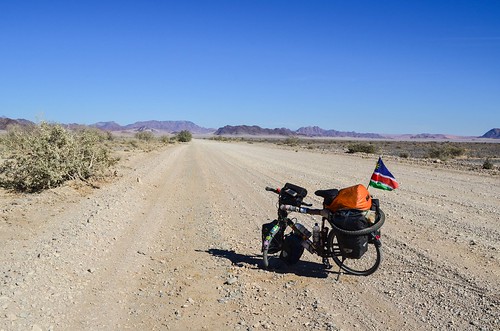
D'altra parte, per ammazzare il tempo durante la mia lenta progressione, ci sono molti gemsbok (orici) da guardare che pascolano su entrambi i lati della strada.
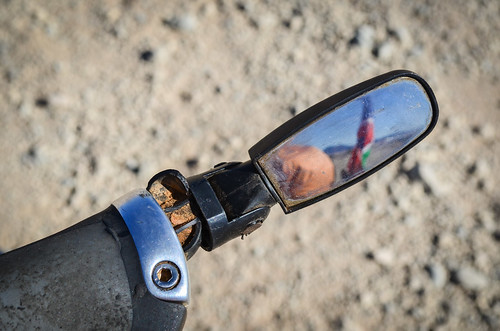
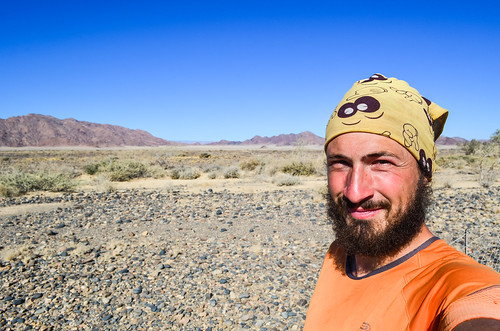

Più avanti su quella strada, passo accanto alla struttura meno probabile in questo tipo di paesaggio: un castello.


This castle is a luxury lodge and spa, called Le mirage. It’s about 20 km from the tourist spot of Sesriem, but there almost nothing around this lodge (hmm, that’s a sentence that applies to most of Namibia anyway). A few kilometers ahead, there is kind of a nice farm-like building, maybe for the managers. And a kilometer after, on the other side of the road, there are a few shacks and dilapidated houses, for the lodge employees (as it is often). That’s where I refill my water bottles, just in case I see no houses tomorrow, and the people there tell me the lodge-castle is full. It is then a successful example of how making nonsense with tourism can work.
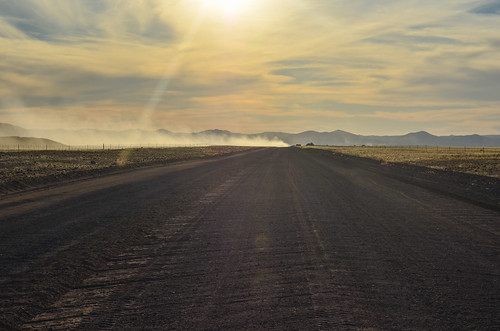
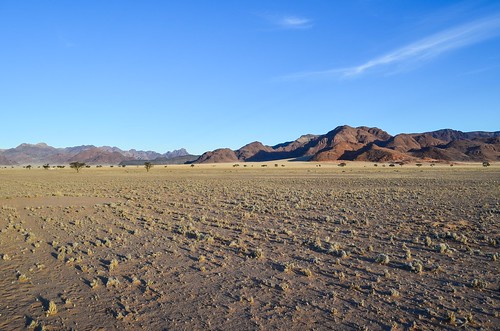
The road I follow, the C27, turns right, still going south. If I head straight, I would join the C19 and reach Maltahöhe140 km later, the biggest town of the area with 6000 inhabitants.
The sun is now setting and I still don’t have a suitable camping spot. Fences are everywhere, and mountains are close, but the sand/gravel of the land is too lose to push my bicycle there within a reasonable time. Even on the road itself, I can’t go faster than 10 km/h, as the gravel surface resembles more sand than laterite. Luckily, in the last minutes of daylight, I find an old concrete water tank just behind a broken fence, so it’s perfect for hiding my tent from the road.
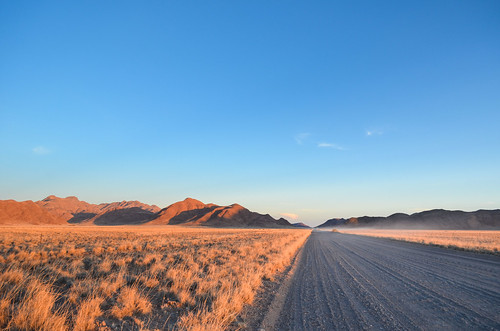

The evening is very silent, but I can hear cars and a very soft buzz afar. It’s probably the generators of the nearest farmhouses, as I know see a few lights afar, about 4 km away according to my relief map of the region. When it’s that quiet, and without any wind, small noise can travel really far. While eating my spaghetti with sweet and sour sauce (hmmmm!), a long “Huuuuuuuuuuuuuu” escapes from the hill just near me.
Another hill, opposite, replies with another “Huuuuuuuuuuuuuuu“. For over a minute, many strong and eerie howls (like questo uno) riempirà il silenzio. Devono essere sciacalli, dato che sono molti nella regione. Possono attaccare un vitello, ma non attaccherebbero mai gli esseri umani. Mi è stato detto che se uno si avvicina a me, senza avere paura, allora potrebbe avere la rabbia. Beh, nel complesso, sono meno preoccupato per gli sciacalli che per le iene. Ma terrò la tenda chiusa per ogni evenienza...

Ho avuto il doppio tetto della tenda che svolazzava al vento tutta la notte, e il vento forte è ancora qui quando mi sveglio. Era molto più caldo delle altre notti, però, come se le temperature potessero cambiare alla stessa altitudine entro 20 km.
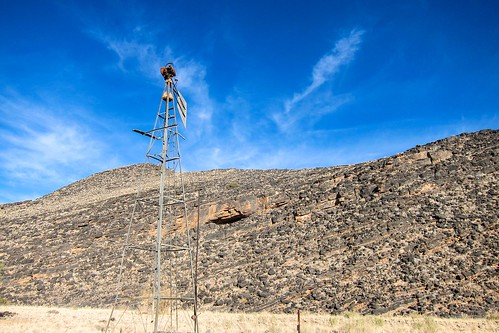
Da ora in poi, la terra intorno a me è finalmente senza recinzioni! E sembra davvero meglio. Le fattorie in quest'area sono così grandi e possono sostenere solo pochi animali, quindi queste recinzioni sembravano comunque inutili. Non ci sono recinzioni per gran parte della mia giornata perché sto attraversando il Riserva naturale NamibRandÈ una riserva naturale privata, la più grande del Sud Africa, fondata da un gruppo di agricoltori che hanno unito le loro terre e rimosso le recinzioni. Ora misura oltre 2000 km2, quasi quanto il Lussemburgo. E la C27 passa proprio attraverso di essa.
La strada è ancora difficile per andare in bicicletta, con ghiaia sciolta e ondulazioni, ma i panorami sono splendidi. Ci sono persino dune rosse di terra morbida.
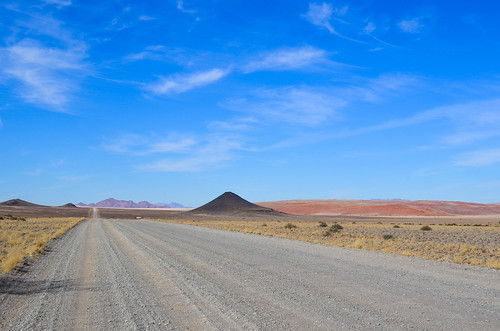


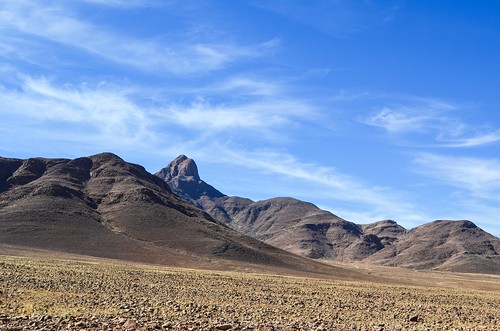

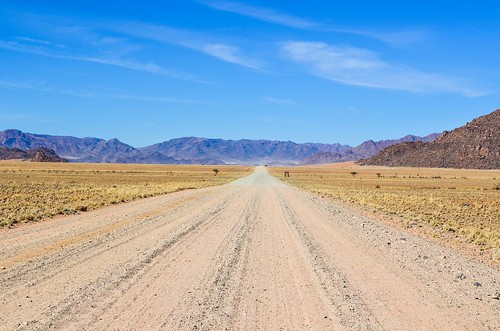

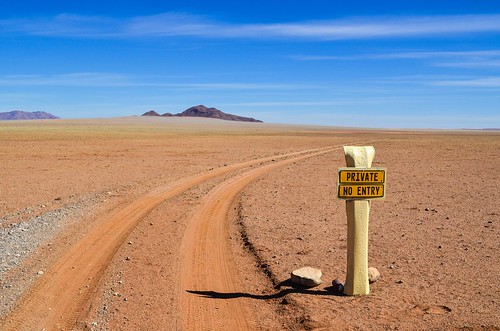
Ho sentito un rumore sospetto nella mia ruota posteriore per un po' di tempo, e non è ghiaia. Quando mi fermo per controllare, mi rendo conto di aver perso una vite sul portapacchi posteriore! Quella stessa vite in basso a destra del portapacchi che era quasi caduta sulle strade pessime della Ring Road nel Nord del Camerun. Questa volta è sparita, ma fortunatamente ho molte di scorta: queste viti Allen da 5 mm servono in tutta la mia bici.
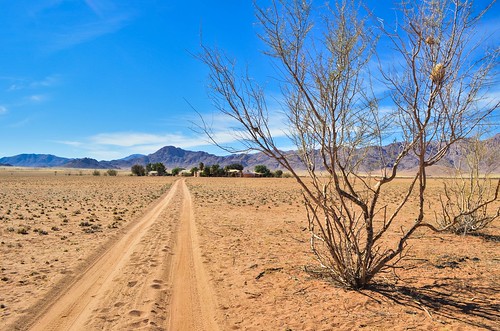
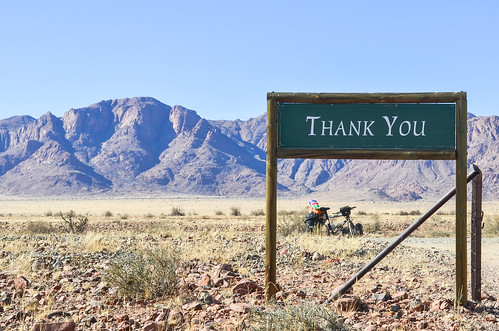
During the entire day, there is only one farm close enough to the road, 2 km on my left. I visit it to fetch water, which I get despite no one showing up. There is a massive solar panel installation though. It’s OK, I probably won’t get the chance to speak to anyone today.
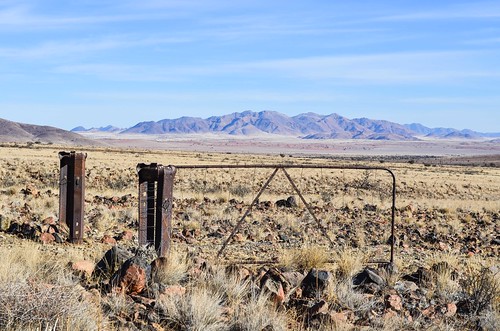

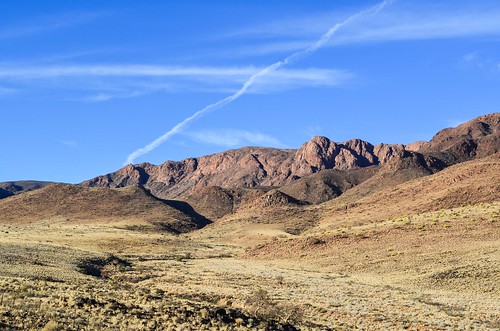

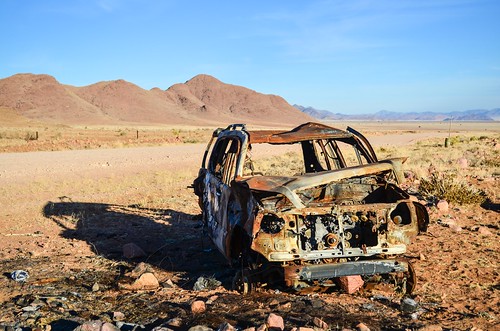
Ci sono molti orici che attraversano la mia strada. La gente del posto spesso dice che è la carne migliore. Ed è anche facilmente reperibile, poiché sono animali selvatici, ma ogni tanto vengono nelle fattorie per essere cacciati e trasformati in biltong.
La strada migliora verso la fine, come se fosse stata recentemente livellata, e al tramonto, dopo aver trascorso abbastanza tempo da solo nei miei migliaia di chilometri quadrati, faccio il check-in nella prima fattoria lungo la strada, Werelend, che per caso gestisce anche un campeggio.
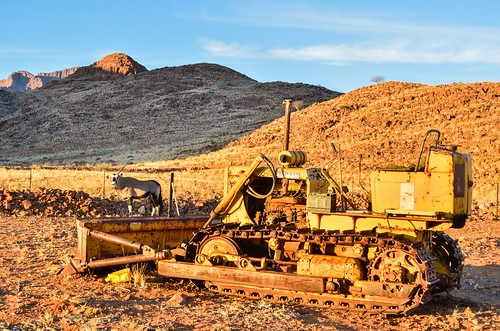
Questo non è un campeggio di lusso, e dubito che qualcuno si fermi qui, ma campeggiando appena dietro la casa del proprietario, godo di una doccia calda e preparo il mio rifugio dal vento. È ora di giocare con quell'orice da compagnia.
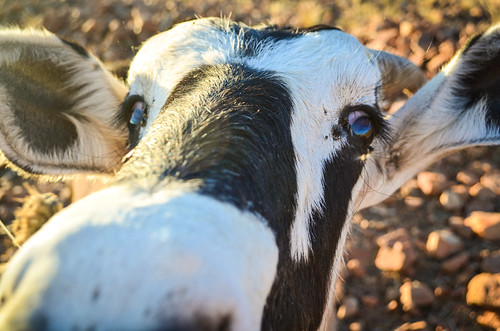
Gli orici non dovrebbero essere animali domestici. Sono selvatici, proprio come i facoceri e i suricati, eppure ho visto una versione addomesticata di ciascuno, precedentemente nelle fattorie della Namibia. In realtà sono gemsboks, una specie del genere orice.
Non ricordo tutta la sua storia, ma suonava così: un cucciolo di orice è stato trovato abbandonato nella fattoria e accudito all'interno della fattoria. È cresciuto con il cane. Sebbene l’orice dovesse rimanere nella fattoria solo fino a quando non fosse stato abbastanza grande per vivere da solo in natura, giocare con il cane gli ha provocato la rottura di un corno.

E con un corno rotto, è quasi ovvio che un orice maschio non possa unirsi a un branco. Verrebbe bullizzato e rifiutato dalla concorrenza. Quindi l'orice con il corno rotto, che sembra un unicorno con un orecchino, è ancora lì oggi vicino alla fattoria, dall'altra parte della recinzione. Non so se voglia ricevere cibo, tutto quello che so è che non mangia spaghetti e che cerca di colpirmi con il suo corno inesistente.

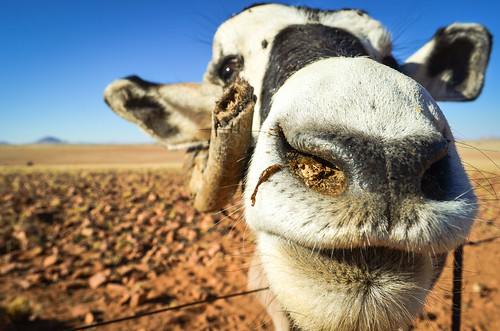
Da ora in poi, sembra esserci più civiltà che vicino a Sesriem. Nelle mie mappe turistiche cartacee, ci sono diversi cerchi tra qui e Aus, sulla strada asfaltata.
The trick is that the paper tourist maps print a circle of the same size for a farm of 5 inhabitants and a town of 20’000, like Tsumeb. How deceiving! Yet, the situation is slightly better than around Sesriem or the Khomas Highland, where all the farms are very remote, and many into luxury tourism. From now on, the farms seem more “social”, in a way that they are located at crossroads of national dirt roads, and not at the end of 10 km of private road. And if they are represented with a circle on the map, it is possible they operate a small shop or a campsite.
Ma prima, dopo aver salutato il gemsbok, dovrò affrontare gli elementi. Fortunatamente, il vento non mi sta rallentando, e anzi mi aiuta un po'. La strada è di nuovo buona e sto semplicemente godendomi un panorama fantastico (devo ripetermi, ma è proprio così che è la Namibia).
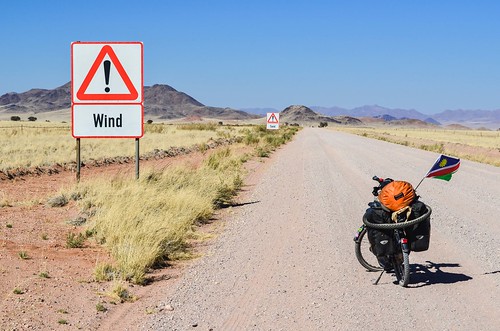
Se si sono presi la briga di segnalare il vento e la sabbia, deve diventare piuttosto difficile a volte.

Ho visto troppo spesso linee elettriche lungo la strada, abbandonate o leggermente danneggiate. Sicuramente, non mantenute. Da quello che ho sentito, direi che è perché molti agricoltori sono passati a una generazione di energia completamente solare, l'investimento risultando rapidamente molto più vantaggioso che pagare NamPower per mantenere cavi nel mezzo del nulla per il bene di alcune fattorie.

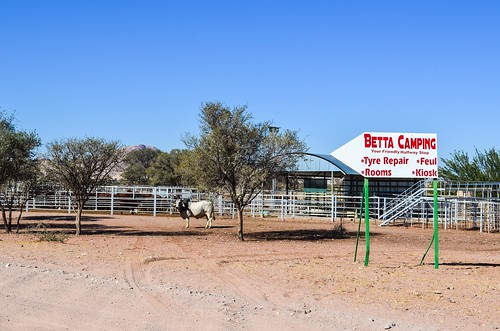
The first farm-at-a-crossroads I meet, and the last for the day, is called Betta. It has a circle on the maps just like a big city (by Namibian standards),and it’s maybe because it provides for everything someone stranded there would need: petrol station, bakkie and tyre repair, small shop, café, camping, rooms, phone signal, and even a few souvenirs! I take there a long break and refill on food with half a kilo of Droewors, the most useful way to carry meat on a bicycle in Namibia.
It’s still too early to sleep here, but it might be wiser to leave in the morning with a complete stock of water. Indeed, what’s coming next is the mighty D707. I have heard enough about this road, and that’s where I am heading to. It has been described as the most scenic road of Namibia, but also as the toughest by Dave: lots of sand and no water. From Betta to Aus, the D707 lasts for almost 200 km.
Dato che so quanto la Namibia possa far sentire un viaggiatore impreparato molto impotente e stupido, preferisco giocare sul sicuro. Ma c'è un'indicazione sul mio GPS che segnala qualcosa a 20 km di distanza. Dopo aver confermato con diverse persone che c'è acqua lì, risalgo in sella e pedalo ancora un po' fino alla fattoria Spes Bona.


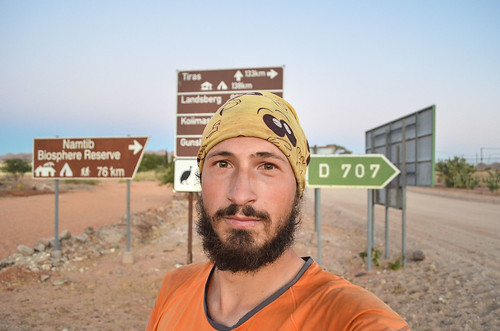
È quasi notte e ci sono diverse case lì. Non avrò problemi a trovare acqua, quindi è un bel posto per accamparsi prima di intraprendere la D707. Devo solo annunciare la mia presenza al proprietario.
I roam around the complex, trying to find someone. The three or four nice houses are fenced and a very angry dog does its job at keeping me away. On the other side of the road, there are much simpler houses and shacks, with chicken and other animals running in between. That’s for the workers. One of them tells me the boss will come back shortly, so I keep roaming around the empty nice houses. It’s now night time.
Suddenly, the boss comes back with a rifle in one hand. It looks quite cliché so far, but I can’t help it, that how it is. The rifle is not for me, he’s probably back from hunting. As usual, I explain my story, cycling, blah blah blah, and he coldly answers that I can camp anywhere.
Basically, I’m just looking for one or two walls to be sheltered from the wind. I thought wind stops during the night, but it’s not always true. I finally set up my tent behind his second house, empty, which looks like a little palace. Almost anywhere in West Africa, I would be answered “I can’t let you sleep outside, you’re my guest!“, but I don’t complain, as I just need water and a spot to build my tent. It seems also true that generally, the more people have, the less they share.
Well, in the case of Namibia, things are more complicated. White people cycling in the bush are not sent by God and tourists sleeping in their tents are already plenty, and everyone knows they do it on purpose. I can’t really state generalities about the White farmers of Namibia, but from my experience, I could say that half are very friendly, inviting and smiling, while the other half remains very cold.
For sure, life in such a remote and arid place is not fun. These people must have arrived here from Germany and South Africa,and took a huge piece of land where nothing grows and where no one would want to go. They ended up with 5 or 10 or 15 thousand hectares of sand and gravel where it barely rains and had to survive with it, building everything from scratch, with no help from anyone else.
And now, they have a farm, cattle and workers, and considering the price of the land they own and the house they built, they are easily multimillionaires (in €). A good million or two for the land, plus the cattle, and mini palaces. Of course, they are only a minority among the 8% of Whites that make up the Namibian population (and I’m sure there is a fair amount of farm owners, rich in assets, but making just enough cash). What I wonder is how weird it must feel to still be doing the farming hard work, when, alongside, tourists are willing to pay a lot of euros just to sleep there, enjoy the desert and the stars, and eat a bit of meat.
La transizione sembra abbastanza semplice: mettere un cartello 'lodge di lusso' sulla fattoria, pulire le camere, ricevere i turisti e smettere di lavorare nei campi. Nel deserto, sembra che metà delle aziende di bestiame lungo le strade siano ora campeggi o lodge di lusso. I campeggi in particolare sembrano soldi facili. D'altra parte, ho incontrato qualcuno che pensa che gestire bestiame e lavoratori neri sia più semplice che gestire turisti, perché non si lamentano mai. Alcuni hanno entrambi (cioè bestiame e un campeggio), continuando comunque la transizione dall'agricoltura al turismo. Il turismo sembra davvero soldi facili, ma potrebbe essere anche meno affidabile del tempo.
Comunque, mi concentro su quella strada D707. I prossimi tre giorni saranno secchi e duri!







Ciao JB,
Mi è piaciuto leggere e vedere le foto del tuo intero viaggio in bicicletta libera. Spero che la vita
ti abbia trattato bene dal 2015. Forse un giorno avrò l'opportunità di incontrarti, anche se
sono nel Michigan, USA.
Grazie per il tuo commento! Ora sono sedentario, ma ho scoperto che un viaggio in bicicletta all'anno mantiene la vita in buona forma 🙂 Stai bene.
Grazie Christina e Ionni!
Buona fortuna con la preparazione del vostro viaggio, sono sicuro che vi divertirete moltissimo.
Sono un'altra persona che legge il tuo blog molto tempo dopo che hai completato questo viaggio. Volevo anche complimentarmi con te per un risultato così straordinario. Sto lentamente lavorando per arrivare dall'inizio. Penso di aver trovato il tuo blog tramite qualche ricerca su Google mentre stavo cercando informazioni per il mio prossimo viaggio (novembre 2016) in Namibia.
Grazie per le storie e le foto straordinarie, sono fantastiche!
Ciao JB, non sono sicuro se leggerai ancora questi commenti tanto tempo dopo il tuo viaggio, ma oggi sono incappato nel tuo blog mentre cercavo bei percorsi in mountain bike da includere in un tour ciclistico che voglio fare in Namibia e in Botswana l'anno prossimo.
Mi piace molto leggere i tuoi post e la foto, ovviamente, è davvero una benedizione!!
Contenuti eccellenti!!
Goditi il Capo Nord, dove sembra che tu stia attualmente pedalando anche tu.
Christina